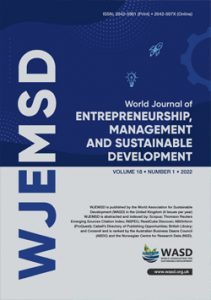Annexing a smart sustainable business growth model for small and medium enterprises (SMEs), Ariful Islam, Prof. Sazali Wahab and Dr. Ahmad Latiff
Ariful Islam
PhD Candidate, Putra Business School (AACSB-Accredited)
University of Putra Malaysia (UPM)
Malaysia
Email: farhan_ctg2012@yahoo.com
Prof. Sazali Abd Wahab
Director-Thesis Based Programme, Putra Business School (AACSB-Accredited)
University of Putra Malaysia (UPM)
Malaysia
Email: sazali@putrabs.edu.my
Dr. Ahmad Shaharudin Abdul Latiff
Senior Lecturer, Putra Business School (AACSB-Accredited)
University of Putra Malaysia (UPM)
Malaysia
Email: shaharudin@putrabs.edu.my
DOI: 10.47556/J.WJEMSD.18.2.2022.2
Purpose: For SMEs, the rate of business failure is alarmingly on the higher side. At the same time, the digital revolution has substantially changed the present business environment and put pressure on SMEs to reflect on their current strategy to achieve sustainable business growth. So, the study attempts to conceptualize an advanced technology-oriented Triple Bottom Line (TBL) layout to configure a smart sustainable business growth model for SME’s long-term survival.
Design/Methodology/Approach: A systematic analysis of literature has been executed to analyze the smart sustainable growth configuration triggered by recent technological advancements, in which over 355 publications are read and reviewed by the authors. The study explores the concept of digital performance to fill the void of “technological advancement for a sustainable solution” as an element in TBL, which is seen as an obstacle that prevents SMEs from being smartly sustainable. Here, validity was aimed at through sampling articles based on established guidelines.
Findings: The outcomes of the study successfully established an adjusted paradigm-the SQBL (Smart Quadruple Bottom Line) with the inclusion of digital performance. The study showed that the strategic convergence of social, economic, environmental, and digital performances has the potential to enable SMEs to survive in the long term. Also besides, the analysis detects probable measurements for digital performance.
Research limitations/Implications: Prior empirical attempts are subsequently required to inquiry about the proposed conceptualization from different perspectives.
Practical implications: This study also indicates that decision-makers, with the efficient implementation of the SQBL, will use the understanding given for their required actions to retain the strategic edge or even competitive advantage of SMEs in terms of economic, social, environmental, and digital (advance technology) concerns. This can be proved beneficial for guiding SMEs to enhance business efficiency and the use of data-driven decision-making.
Social implications: It may encourage building a community of agility, innovation, and collaboration based on the concept of the SQBL and guide to the attainment of the objectives related with climate change.
Originality/Value: This article is the first to analyze digital performance as a new dimension of the TBL layout to achieve smart sustainable growth for SMEs. The SQBL platform promises to contribute significantly to the success of more comprehensive and sustainable SMEs, as well as to extend the current literature on sustainability and digitalization.
Keywords: Innovation; Digital Performance; SDGs; Society 5.0; SME; Sustainable Growth; TBL.
Citation: Islam, A., Wahab, S.A. and Latiff, A.S.A. (2022): Annexing a Smart Sustainable Business Growth Model for Small and Medium Enterprises (SMEs). World Journal of Entrepreneurship, Management and Sustainable Development, Vol. 18, No. 2, pp. 185–209.

